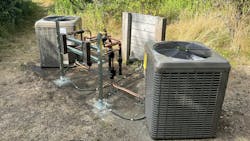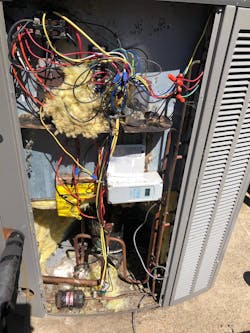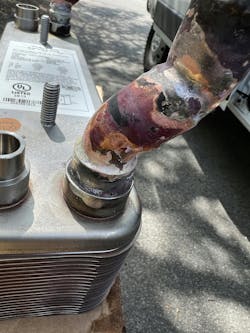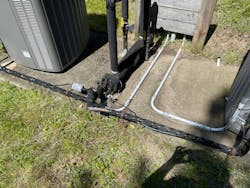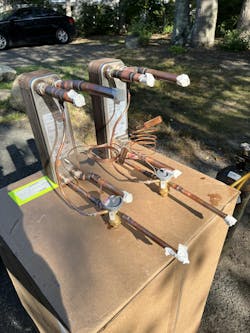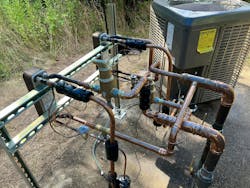Service Mice and Landscapers Cripple Aging Chiller Plant
This chilled water rescue involved a remote chilled water plant with two 5-ton condensing units connected to a shell and tube heat exchanger that provided chilled water to air handlers inside the home 100 feet away.
Some of our rescues take place over the course of a year and we have ample time to investigate, research, and then propose a solution. We then have time to carefully resolve the various issues and test operation of the mechanical systems to make sure our rescue is successful. In this case, we had a week!
Catastrophic Series of Events
A catastrophic series of events led to the complete failure of this chilled water plant in the middle of the cooling season and we had to hustle to develop a plan and then do the work to restore cooling. Our first impression when we arrived for our initial assessment was that this chiller plant had seen better days—the condensing units were 20 years old, all of the pipe insulation was brittle and cracked, the refrigerant piping was resting on the concrete pad, and both units were filled with mice! It was clear that these units had not been maintained in a while and the mice had moved in and decided to stay!
Behind closed doors, we jokingly refer to our rodent friends as “service mice” as they are so profoundly destructive to control wiring and control boards on outside equipment. If there is a good acorn season, then the rodents are busy in their forest homes during the winter as there is lots to eat. If there is a bad acorn season, then the rodents invade outside condensers and heat pumps looking for food and protection from the elements.
Invariably, they chew up control wires and insulation and destroy control boards—they certainly create a lot of service work for our service department in the spring when cooling systems are turned on. And many thanks to the genius that decided to develop corn-based insulation for wires! Our service mice are overjoyed to spend the winter in a warm heat pump surrounded by yummy wires! If they are lucky, only a few of them will get electrocuted and whatever damage they do won’t be noticed until the spring.
We use a lot of moth balls to deter the mice but we do have some customers that are horrified that we would put “cancer causing chemicals” in their equipment! They don’t believe us when we say the moth balls are the “free range organic kind” (ha!)—but they often come to their senses when we inform them that all of their neighbors have moth balls in their outside units so, most assuredly, all of the neighborhood mice will be spending the winter in any outside unit with no moth balls.
Kicking Out the Service Mice and Repairing The Damage
At this point, this project would seem to be a simple service project of kicking out the service mice, repairing or replacing the damaged wires, cleaning the outside units, and firing up the condensers to make some chilled water. Unfortunately, things weren’t that simple.
While we were proceeding with our repair work, we determined that the outside units were low on R22. Because it was the middle of summer, the homeowner had no appetite for any project that might delay getting the cooling working. So we proceeded with a leak test on the outside units, piping, and the shell and tube heat exchanger. Surprisingly, the outside units and the vapor and liquid lines held pressure. But several braze joints were leaking on the ancient shell and tube heat exchanger.
We tried mightily to clean up the old braze joints and patch the leaks but were not successful at completely stopping the leaks. The homeowner decided to have us recharge the units with R22 and repair the leaks after the cooling season. We got the two condensers running, water flow restored through the shell and tube heat exchanger, and chilled water was once again flowing to all of the inside air handlers. Another successful service call? Not so fast!
Landscapers Help Us Modernize the Chiller Plant
The moment after the homeowner started to relax in his nicely cooled home, the mowing crew came out to mow the grounds. We got the anguished phone call from the homeowner—the mow crew had put the new guy on the mower and he had sailed right into the refrigerant pipes and shell and tube heat exchanger! He leapt off the mower as he was enveloped in twenty pounds of R22 violently escaping into the air!
Luckily he was OK, but the chilled water plant was destroyed! Both aging compressors immediately seized up and all cooling stopped inside the home. This simple service call had turned into a chilled water rescue.
The Scramble To Source Parts
Now we had to hustle—it was still the middle of summer and we had to figure out how to assemble a new chilled water plant.
Sourcing two vanilla 5-ton condensing units was simple. The more involved part was sizing and sourcing the correct brazed plate heat exchangers and the appropriate TXVs. Living on the island of Martha’s Vineyard means that everything takes longer to get (Next Day Air is actually the Day After Next Day Air) and everything has to come by either mail order or ferry from our off-island supply houses.
We finally had all of the parts we needed and we started our assembly process. We did get stalled on the brazing of the heat exchangers—we are usually really good at having extra of everything but we actually ran out of flux and brazing rod for stainless steel. No one had any on the island so we had to wait for our next delivery truck to come over on the ferry. Once we got the right flux and rod, the brazing between copper and stainless steel was easy and we assembled the two heat exchangers and their TXVs. Our goal was to prefab as much as possible to expedite the work in the field.
Strut Frame to Prevent More Mow Crew Mischief
Our advance team had already cleared away the two dead condensers and the shell and tube heat exchanger so we arrived to a clean slate. We erected a strut framework to get the heat exchangers off the pad and give them some protection from the mow crew. We slid the two new 5-ton condensers in place and mocked up the refrigerant lines. It made sense to angle both outside units to simplify the refrigerant piping to the heat exchangers.
We were aware of our very tight time budget at every step of this rescue. We elected to braze all of the refrigerant lines (our new construction department was happily and successfully zoom locking all of their refrigerant lines but my old school ways said different) and press all of the water lines. To balance the water flow through both heat exchangers we set up a reverse return arrangement so that both heat exchangers would see run and branch flow.
System Completion and Start Up
We got both outside units running and started making chilled water again and restored cooling inside the house. Another successful rescue!
(And we put moth balls in the outside units to discourage any “service mice” that might be contemplating moving in for the winter.)
PARTS & EQUIPMENT
Heat exchangers by Alfa Laval
TXVs by Sporlan
Braze Rod and Flux by Harris
Strut by Superstrut
Air separator by Spirovent
Press fittings by NIBCO
Condensing units by York
About the Author
Brian Nelson
Brian Nelson is the co-owner of Nelson Mechanical Design, a “green” mechanical contractor serving the energy efficiency and home comfort needs of Martha's Vineyard, MA since 2004. The company designs, installs, and services just about anything to do with heating, cooling, domestic hot water, water treatment, geothermal, heat pumps, and radiant. NMD is committed to preserving the fabric of the Island it calls home. To learn more visit nmdgreen.com.
